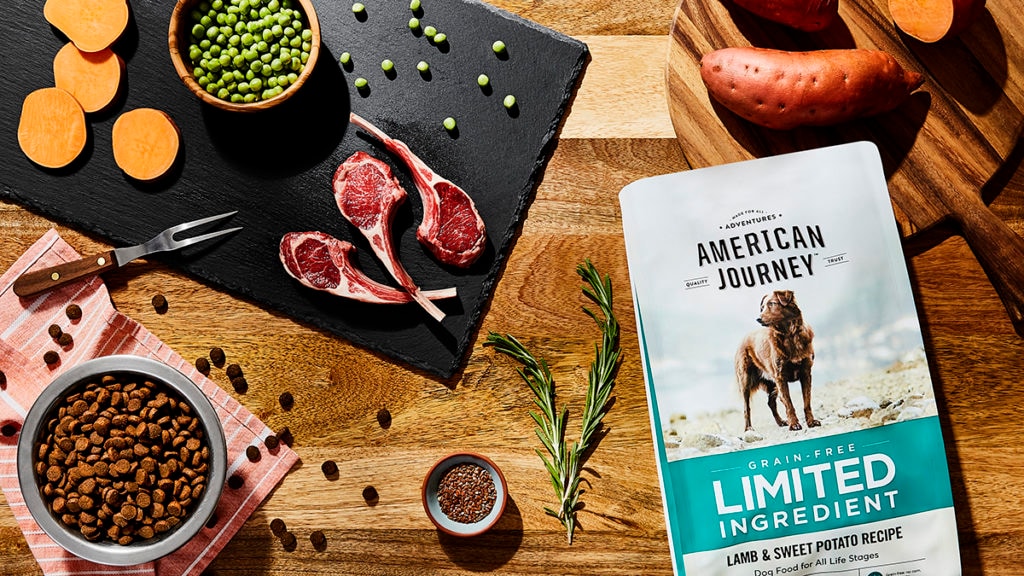As pet parents, we’ve all been there. You search for the best cat or dog food to feed your pet, and you come across a limited ingredient diet (LID) pet food, only to wonder what they’re all about. After all, why would anyone want to choose a dog food or cat food that is limited in any way?
As with people, some pets are allergic or sensitive to certain ingredients found in kibble or wet food. According to Sarah Wooten, DVM, at Sheep Draw Veterinary Hospital in Greeley, Colorado, these food sensitivities can show up as symptoms on your pet’s skin—annoying itching, excess shedding and even hot spots—or in his tummy as excessive gas, diarrhea or loose stool.
Limited ingredient diets are designed to address these health concerns. And even if your four-legged friend doesn’t suffer from pet allergies or their frustrating symptoms, LID pet foods, like American Journey Limited Ingredient Diet dog food, are formulated to provide complete and balanced meals while helping to keep food sensitivities at bay.
What Makes a Limited Ingredient Diet?
The reason for choosing a limited ingredient diet is simple; choosing which one to feed your pet is a whole other story. Pet food labels can get pretty confusing, making it difficult to tell exactly what makes any pet food qualified to bear the LID name. The basic principle is this: There’s less of some things and more of others in the bag (or can). So, let’s take a closer look.
1
A single protein source.
LID pet foods usually are made with one protein source. That’s very important to help prevent pet food sensitivities.
“Proteins are broken down through digestion into molecules that the immune system can incorrectly see as a potential threat,” says Dr. Coates, “and this causes food allergies and their symptoms.”
Limiting the protein to only one type can go a long way to keep sensitive pets healthy.
2
A single source of carbohydrates.
The same principle that applies to having a single source of protein applies to carbohydrates. Some pets are sensitive to ingredients that are added to pet foods as a source of carbohydrates. That’s why veterinarians like Dr. Wooten recommend pet foods that limit the number of carbs in the recipe, in addition to a single protein.
3
Novel protein sources.
A novel protein source is any animal protein that your pet hasn’t eaten in the past. The idea is this: If it’s never made it to your pet’s dinner bowl, it’s less likely to be a trigger for food allergies, Dr. Wooten explains.
Chicken and beef are common pet food proteins, and it’s likely your pet has already those proteins. LID diet recipes might include a less common meat like duck, salmon and lamb. For example, American Journey duck and sweet potato limited ingredient diet dog food also comes in salmon and lamb recipes and contains high-quality animal proteins specially selected for sensitive pets.
4
No grains like wheat, corn and soy.
We’ve looked at what you’ll find in limited ingredient pet food. Now let’s look at what you won’t find—starting with ingredients known to be linked to food allergies: wheat, corn and soy.
According to some research, these ingredients, which are commonly found in many pet foods, may act as food allergens and can flare up sensitivities in pets—especially dogs. For that reason, some veterinarians suggest opting for meals that are free of these, and limited ingredient diets usually deliver on this.
5
No artificial ingredients.
Although there aren’t extensive studies linking artificial ingredients to pet food allergies, you’re unlikely to find any of these in limited ingredient diets.
The LID less-is-more approach is based on crafting recipes with as few ingredients as possible, while still providing the nutrition pets need for overall health. Things like artificial colors, flavors or preservatives don’t add any nutritional value, so they’re usually nixed from the ingredients list in LID recipes.
Next time you’re shopping around for dog food or cat food, you now will be able to tell a LID pet food from the rest, and you’ll be savvy about their benefits. Whether your pal is showing signs of pet food allergies, like an upset tummy or skin and coat issues, or you just want to feed him the best food possible to keep him healthy, consider filling the bowl with a limited ingredient diet pet food.
Share:










